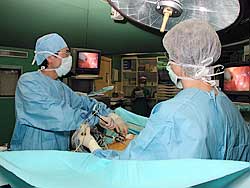
As with any potentially serious decision, the best course of action is to take no action until you are fully informed about your situation. Prostate cancer usually advances relatively slowly compared to other cancers, and in general there is no need to rush into any decisions.
In particular you should ask about your prostate cancer's grade and stage, as when you look at your options you'll see these make a real difference to the treatments available to you.
Don't dash into rash action, because you need to fully appreciate the consequences of what you're deciding; the side effects of many treatments are not fully predictable and can have dramatic, sometimes distressing, consequences for your quality of life.
As with all diseases, your treatment for prostate cancer will depend on a number of factors such as your age and whether the cancer has spread and if so, how far. Below we give a brief outline of the various treatments currently available and others that may be here soon. Be sure to discuss everything with your doctor.
Sometimes, particularly for slow-growing tumours, no treatment, just active monitoring or "watchful waiting" is the best course of action. "Watchful waiting" means closely monitoring a patient’s condition without giving any treatment until symptoms appear or change.
It is popular with men over 70, sometimes with other medical problems, who.have been diagnosed with low grade or early-stage prostate cancers. If you're younger and only have a lowest grade cancer you may want to go this way, at least for a while, for life-style or family reasons. However, some experts say that even slow growing cancers may progress quickly and affect a man's health.
Surgery is a common treatment for prostate cancer, but has unavoidable side-effects that might be distressing. It is most suitable for otherwise healthy men (usually, those under 70) whose cancer has not spread beyond the prostate. It involves four to five days in hospital and another four to six weeks recuperating at home.
This is a surgical procedure to remove the lymph nodes in the pelvis to see whether the prostate cancer has spread to them. A pathologist views the tissue under a microscope to look for cancer cells. If the lymph nodes contain cancer, the doctor will not remove the prostate as the cancer is then deemed to be surgically inoperable and may recommend other treatment.
The most common technique is a radical prostatectomy. This is a major operation, which removes the whole of the prostate, seminal vesicles and nearby lymph nodes. There are two types of radical prostatectomy:
A surgical procedure to remove tissue from the prostate using a resectoscope (a thin, lighted tube with a cutting tool) inserted through the urethra. This procedure is sometimes done to relieve symptoms caused by a tumour before other cancer treatment is given. Transurethral resection of the prostate may also be done in men who cannot have a radical prostatectomy because of age or illness.
Impotence and leakage of urine from the bladder or stool from the rectum may occur in men treated with surgery. The risk of impotence (inability to get an erection) can be as high as 70%, while the risk of incontinence (inability to fully control leakage of urine) can range from 2% to as high as 30%.
Some specialists offer “nerve sparing” and “nerve grafting” procedures during surgery to minimise the risk of impotence. This type of surgery may save the nerves that control erection. However, men with large tumours or tumours that are very close to the nerves may not be able to have this surgery.
Next page: More Prostate cancer treatments: Radiotherapy, Chemotherapy, Hormone therapy
Deprecated: Invalid characters passed for attempted conversion, these have been ignored in /usr/home/travelsignposts/public_html/yourprostate/powerrss/scopbin/911006.php on line 1
Deprecated: Invalid characters passed for attempted conversion, these have been ignored in /usr/home/travelsignposts/public_html/yourprostate/powerrss/scopbin/911006.php on line 1
Deprecated: Invalid characters passed for attempted conversion, these have been ignored in /usr/home/travelsignposts/public_html/yourprostate/powerrss/scopbin/911006.php on line 1
Deprecated: Invalid characters passed for attempted conversion, these have been ignored in /usr/home/travelsignposts/public_html/yourprostate/powerrss/scopbin/911006.php on line 1